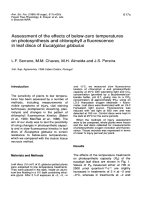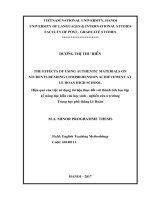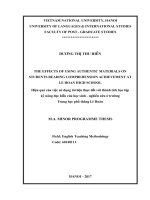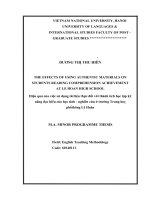the effects of reading authentic materials on english majored students writing skills in thang long university
Bạn đang xem bản rút gọn của tài liệu. Xem và tải ngay bản đầy đủ của tài liệu tại đây (1.74 MB, 30 trang )
<span class="text_page_counter">Trang 1</span><div class="page_container" data-page="1">
<b>STUDENT’S NAME : NGUYEN VAN ANHSTUDENT’S CODE : A34083</b>
<b>HA NOI, 2023</b>
</div><span class="text_page_counter">Trang 2</span><div class="page_container" data-page="2"><b>1.5. Significance of the study...2</b>
<b>CHAPTER 2.LITERATURE REVIEW...4</b>
<b>2.1. Theoretical framework...4</b>
<i>2.1.1. Writing skill...4</i>
<i>2.1.2. Authentic materials...5</i>
<i>2.1.3. The effect of using authentic materials...5</i>
<i>2.1.4. Authentic materials in teaching writing...6</i>
</div><span class="text_page_counter">Trang 3</span><div class="page_container" data-page="3"><i>(none)</i>
</div><span class="text_page_counter">Trang 4</span><div class="page_container" data-page="4">EFL: English as a Foreign Language FL: Foreign language
</div><span class="text_page_counter">Trang 5</span><div class="page_container" data-page="5">Writing skills have long posed a significant challenge for English as a Foreign Language (EFL) learners in Vietnam. The existing predicament revolves around the inefficacy and inadequacy of materials within conventional textbooks. To address this challenge, the research proposes a pragmatic solution - the integration of authentic materials to enhance students' writing abilities. The study's primary objective is to assess the impact of authentic reading materials on the writing proficiency of third-year English major students at Thang Long University. With an intended cohort of 80 participants, this research will employ a mixed-method approach. It will begin with a pre-test to establish a baseline, followed by the application of authentic reading materials in the teaching process. This novel method aims to engage and captivate students while improving their writing skills. The journey will conclude with a post-test to gauge the progress made, and the qualitative data collected will be meticulously analyzed using an analytic rubric. This study holds the promise of offering an innovative pedagogical approach, addressing the pressing issue of improving writing skills, thereby potentially revolutionizing English language education within the Vietnamese context.
<b>Key words: writing skills, authentic materials, teaching method</b>
</div><span class="text_page_counter">Trang 6</span><div class="page_container" data-page="6"><b>1.1.Background of the study</b>
In the realm of English language learning, writing skills have consistently proven to be a challenging endeavor for students. The process of constructing well-articulated and coherent written content requires a nuanced understanding of language, vocabulary, and grammar. However, the current teaching landscape often falls short in providing students with the necessary tools to enhance their writing abilities. A prominent issue is the lack of authentic materials that can serve as practical and relevant models for effective writing. Students are frequently exposed to contrived exercises and artificial contexts that fail to mimic the real-world scenarios they will encounter when utilizing their writing skills. Consequently, there exists a significant gap between the teaching methodologies employed and the actual demands of proficient writing. It is within this context that the significance of authentic reading materials becomes evident.
Authentic reading materials not only expose students to genuine language usage but also provide real-world content that is relevant and engaging. In this regard, the connection between authentic materials and writing skills is paramount. By engaging with authentic texts, students can observe and internalize the structure, style, and tone of proficient writing in various contexts, from formal reports to informal blog posts. These materials offer tangible examples of how language is effectively employed to convey ideas, argue points, and narrate stories. Furthermore, they introduce students to diverse vocabulary and language patterns, fostering linguistic flexibility that is essential for adept writing.
The utilization of authentic reading materials stands out as a promising approach to address the writing challenges faced by English majors at Thang Long University. This approach centers on the incorporation of real-world texts, such as articles, essays, and literature, into the curriculum. These materials mirror the type of content students are likely to encounter in their academic and professional lives, bridging the gap between classroom learning and practical application.
Therefore, the primary aim of this research is to investigate the effects of integrating authentic reading materials into the teaching of writing skills. By exploring how such materials impact students' writing proficiency, we aspire to shed light on the potential of this approach in enhancing the writing skills of
</div><span class="text_page_counter">Trang 7</span><div class="page_container" data-page="7">English majors at Thang Long University. The research is not only expected to contribute to the academic discourse on language education but also to provide practical insights for educators and curriculum development. In a broader context, this endeavor aligns with the overarching goal of equipping students with the language skills required for success in their academic and professional endeavors.
<b>1.2.Research problem</b>
The research problem centers on the difficulty students face in developing strong writing skills. This challenge is exacerbated by the absence of authentic materials that truly represent real-world writing. Current teaching methods often rely on contrived exercises and artificial contexts, leaving students ill-prepared for the demands of practical writing. Authentic materials can bridge this gap by providing students with genuine examples of proficient writing. By connecting students with real-world reading materials, we aim to offer them models of effective writing in various contexts, such as essays, articles, and literature. This research seeks to explore how integrating authentic reading materials into writing instruction can address these challenges and empower students to become more competent writers. It offers insights for educators looking to enhance writing skills by connecting classroom learning with real-world applications.
<b>1.3.Research purpose</b>
The research aims to assess how authentic reading materials influence the writing skills of English major students at Thang Long University.
<b>1.4.Research Question</b>
<i>What are the effects of authentic reading materials on the writing skills ofEnglish-major students at Thang Long University?</i>
<b>1.5.Significance of the study</b>
In the context of Vietnam's education system, students often encounter difficulties when learning the intricacies of writing skills. One key challenge arises from the scarcity of authentic teaching materials that resonate with the unique needs and expectations of students. This deficiency leads to a mismatch between traditional teaching methods and the contemporary writing skills that students need to excel in both academic and real-world settings. Understanding the impact of authentic reading materials on writing skills is of paramount significance to
</div><span class="text_page_counter">Trang 8</span><div class="page_container" data-page="8">teachers, as it offers them a promising avenue to enhance their instructional strategies. Likewise, students stand to benefit by gaining access to engaging and pertinent materials that can help them sharpen their writing abilities effectively. Furthermore, educators have much to gain from this research, as it provides insights into more effective pedagogical approaches that can be applied broadly to improve writing skills in the Vietnamese educational landscape. By delving into the relationship between authentic reading materials and writing skills, this research bridges a crucial gap, illuminating a path to more effective writing instruction in Vietnam.
</div><span class="text_page_counter">Trang 9</span><div class="page_container" data-page="9"><b>2.1.Theoretical framework</b>
2.1.1. Writing skill
Writing in a second language is a particularly challenging endeavor, requiring not only linguistic competence but also cognitive and communicative skills (Dar & Khan, 2015; Hyland, 2003; Mahboob, 2014). The process of writing involves memory, thinking, and verbal ability to effectively convey ideas (Kellogg, 2001). Therefore, the ability to write proficiently is an indicator of successful second language learning (Geiser & Studley, 2002; Hyland, 2003; McCutchen, 1984; Nickerson, Perkins, & Smith, 2014). Writing has gained increased importance due to its role in effective idea communication and the extensive research conducted on the challenges faced by second language writers (Dar & Khan, 2015; Graham & Perin, 2007; Haider, 2012; Hyland, 2003).
Student writers encounter various problems throughout their learning journey, which can be categorized into linguistic, psychological, cognitive, and pedagogical issues (Haider, 2012; Hyland, 2003). They often grapple with English's structural components, as inappropriate structures can complicate the text's content and comprehension, which a reader deciphers through involvement in a mental process (Quintero, 2008; Nik, Hamzah, & Rafidee, 2010). Similarly, incoherent writing hinders effective idea communication, leading to a lack of confidence in learners, even if they possess strong syntactic, lexical, and grammatical command over composition (Rico, 2014). Students' lack of confidence is also caused by a teaching strategy that does not conform to students' learning styles and cultural backgrounds (Ahmad et al., 2013).
These issues stem from various factors, including teacher-related and student-related challenges. Teachers often lack appropriate pedagogic approaches for teaching writing, including providing prompt and effective feedback to students. More crucially, teachers may struggle to motivate students effectively. On the other hand, students face numerous challenges, including the effects of first language transfer, lack of reading, motivation, and practice (Bilal, Tariq, Din, Latif, & Anjum, 2013; Dar & Khan, 2015; Haider, 2012; Mahboob & Talaat, 2008).
</div><span class="text_page_counter">Trang 10</span><div class="page_container" data-page="10">Authentic materials
Authentic materials, in the context of language learning, refer to texts or resources that are created for native speakers of a language and are used in real-life situations. These materials provide learners with exposure to genuine language usage, reflecting the language as it is naturally spoken and written by native speakers. Examples of authentic materials include newspapers, magazines, podcasts, TV shows, movies, and literature. Using authentic materials in language learning can greatly benefit students by exposing them to the nuances of the language, helping them understand cultural contexts, and improving their overall language proficiency. Moreover, authentic materials make learning engaging and relevant, as students are exposed to content that interests them and is immediately applicable to real-world situations. Incorporating authentic materials into language lessons enhances listening, reading, and critical thinking skills, making them a valuable resource for educators and students alike.
2.1.3. The effect of using authentic materials
Setyowati (2019) conducted a study on the effect of authenticity in writing teaching. The result revealed that the use of authenticity would help the students to acquire the language better and sharpen their critical thinking ability.
The other study was done by Setyowati (2019) on why foreign language (FL) writing teachers/lecturers should utilize authentic materials for teaching writing. Based on the result of this study, there are three main reasons why authentic materials should be utilized for classroom teaching, namely
They create a bridge which connects the artificial world (classroom) and the real world context.
They are interesting and motivating (its realistics and its various platforms).
They can trigger autonomous learning because these types of materials are available everywhere, both printed and online.
According to Maroko (2010), the materials will expose learners to a wide range of natural business language that is employed in the composition of the functional texts in the workplace. Authentic materials will also bring reality to the classroom and make interaction meaningful. Therefore, it is certain that using
</div><span class="text_page_counter">Trang 11</span><div class="page_container" data-page="11">authentic materials can bridge the gap between the artificiality of the classroom and the reality of the outside world.
Similarly, the use of authentic materials proved to increase students’ writing score in writing procedural text. Arifa (2011) suggested English teachers use authentic materials to increase English skills of students and bridge the gap between
<i>what the students learn in class with the use in real life.</i>
By conducting an experimental case study to make comparison between a control group (taught by using traditional method) and an experimental group (taught by incorporating newspaper method), Lavinia (2018) concluded the use of newspaper articles during English classes is a useful, interesting and effective method which grabs students’ attention and provides the teacher with countless possibilities of designing interesting activities.
Authentic materials are believed to contribute to the improvement of students’ written output; however, there were certain challenges observed in the submitted writings of learners throughout the course such as grammar errors, punctuation or capitalization (Elmoisheer and Elsawy, 2002).
2.1.4. Authentic materials in teaching writing
Using authentic materials in English as a Foreign Language (EFL) teaching, such as real-world scenarios, native speakers' communication, and materials created for general use, aligns with a constructivist approach to education (Clark, 2018; Gómez Rodríguez, 2016). These materials come in both oral and written forms, found in oral media, films, news broadcasts, as well as print magazines and periodicals. Integrating authentic materials into teaching enhances student engagement and encourages exploration of the language through real-world tasks, ultimately making the learning experience more interesting and purposeful (Nguyen et al., 2022). This approach fits well with constructivist principles, facilitating student-centered learning (Nguyen et al., 2022). Corpora, which are computerized collections of natural language texts, provide another source of authentic materials. They support data-driven learning, where students interpret data in context, making grammar less abstract (Karaaslan, 2016). Social media platforms like Twitter are also valuable sources of authentic language data, contributing to language studies (Herdağdelen, 2013). The use of authentic materials enhances grammar and vocabulary acquisition and provides a cost-effective way for teachers to create a
</div><span class="text_page_counter">Trang 12</span><div class="page_container" data-page="12">language-focused learning environment (Alina & Lavinia, 2018). This approach contributes to improving EFL writing skills by creating a more engaging and focused learning atmosphere (Alina & Lavinia, 2018).
<b>2.2.Previous study</b>
The study conducted by Elmoisheer and Elsawy (2022), which aims to investigate the influence of authentic online reading materials on students' written outputs, is highly commendable. This research tackles the pressing demand for effective and engaging teaching methodologies. The utilization of a quantitative one-shot pretest-posttest experimental design offers a structured method to assess the effectiveness of the intervention. The focus on improving students' writing skills through reading authentic materials aligns with the principles of constructivist learning, where students actively engage with real-world content. The approach of having students discover paragraph writing conventions through critical reading and then applying these conventions in their own writing is pedagogically sound. It promotes experiential learning, enabling students to connect theory and practice. The study's use of a writing test with an analytic rubric for measurement adds rigor to the research methodology. The study's positive findings regarding the significant improvement in students' performance in writing summaries and reflective essays after engaging with authentic materials underscore the effectiveness of the approach. It highlights the potential of using authentic online courses to enhance English as a Foreign Language (EFL) writing performance. However, it's essential to consider potential limitations, such as the specific context and participant demographics. Additionally, future research could explore the sustainability of the observed improvements and the transfer of these skills to other writing tasks. Overall, this study provides valuable insights into improving EFL writing and underscores the benefits of integrating authentic materials into language education.
Elsulukiyyah and Aisyah's (2019) study employs an innovative approach by utilizing authentic materials to improve students' writing skills in an essay writing class. These authentic materials, originally created for real-world language use rather than educational purposes, are harnessed to improve student writing through a three-cycle Classroom Action Research initiative. The study's main objective is to outline the implementation of authentic printed materials in the writing class and assess their impact on student writing achievements. Notably, while the initial two
</div><span class="text_page_counter">Trang 13</span><div class="page_container" data-page="13">cycles did not meet the desired goals, the third cycle achieved the defined success criteria. In summary, this research highlights the efficacy of authentic materials in enhancing student writing skills, with potential applications in various language courses. The study's focus on improving writing skills is commendable and aligns with the significance of this language proficiency. However, it would benefit from providing more detailed information about the nature and sources of the authentic printed materials used. Moreover, a deeper exploration of why the first two cycles fell short of success and the specific adjustments made in the successful third cycle would enrich the research. Despite these minor limitations, the study offers valuable insights into the practical advantages of integrating authentic materials into language classrooms.
</div><span class="text_page_counter">Trang 14</span><div class="page_container" data-page="14"><b>3.1.Research Design</b>
To assess the impact of incorporating authentic reading materials on writing skills, the researcher employs a case study design involving two distinct groups: a control group that receives traditional writing instruction and an experimental group that integrates authentic materials. These groups are part of the same writing class for third-year English majors, taught by a single teacher, thereby minimizing potential external factors that can influence the study's outcomes.
<b>3.2.Sampling and population</b>
This research will take place in October 2023 at Thang Long University. The participants of this study are 80 third-year English majors at Thang Long University and are divided into two classes of 40 students.
<b>3.3.Research instruments</b>
This case study draws inspiration from the research conducted by Elmoisheer and Elsawy (2022) with some slight adaptations. Qualitative data will be gathered through pre-tests and post-tests, and the analysis process will involve the utilization of the analytic rubric developed by Elmoisheer and Elsawy (2022).
3.3.1. Pre-test and post-test
To address the research question, this study will gather and analyze pre-test (Appendix 1) and post-test (Appendix 2) results from both the control group and the experimental group, with a specific emphasis on assessing writing skills. The chosen format for the test is essay writing.
3.3.2. Analytic Rubric
The assessments (Appendix 3) are intricately structured to assess proficiency in three critical dimensions of writing. These encompass the organization and elaboration of ideas within the written work, proficiency in applying grammatical rules, employing a diverse and sophisticated vocabulary, and adhering to appropriate stylistic elements, while also ensuring precision in the mechanical aspects of writing.
<b>3.4.Research procedures</b>
A total of 80 students, with 40 in each class, are being selected to participate in this research. The study, set to commence in October 2023 and lasting for nine weeks, equivalent to a standard semester at Thang Long University, aims to
</div><span class="text_page_counter">Trang 15</span><div class="page_container" data-page="15">evaluate the impact of integrating authentic reading materials on students' writing skills. Both groups will undergo a pre-test before the study commences to establish a baseline. During the nine-week period, the experimental group will engage with authentic reading materials to enhance their writing skills, while the control group will receive conventional textbook-based writing instruction. In week 7, students from both groups will be assessed through tests to collect data. The analysis of this data will be conducted utilizing the analytic rubric developed by Elmoisheer and Elsawy (2022), designed to evaluate three essential facets of writing: the organization and development of ideas, the application of grammar, vocabulary, and style, and the mechanical aspects of writing.
</div>








